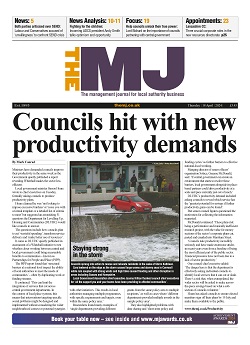Michael Gove has marked the card of local government to build the social housing the country desperately needs.
For the secretary of state there’s an irrevocable moral case for providing homes regardless of tenure that overrides the traditional Conservative political fear that building social housing merely serves to accommodate lifelong opposition voters, whereas home-ownership opens the door to a lifetime of true blue support.
And clearly, judging from the markedly aggressive and effective approach taken with developers over high rise cladding, the moral case is gloved in an iron will that will seemingly brook no opposition.
Measures outlined in the Queen’s Speech this week will eventually seek to simplify the Community Infrastructure Levy and Section 106 regime to put councils in direct charge of delivering directly housing themselves, ending the by now traditional dance around the handbags with developers over affordable housing commitments.
So the legislative juggernaut will see planning and social housing fused and folded into the levelling up plans. A juggernaut that recycles what survived of the Planning for the Future White Paper ambitions before the Chesham and Amersham by-election car crash sent the rogue algorithm to the scrapheap of planning history. We evinced, from the Levelling Up White Paper itself, a certain magical thinking that the mere hitting of the more relevant of the dozen missions would naturally translate into demand for new builds on brownfield sites in the North and Midlands by the end of the decade.
However, an expansion in council housebuilding will need to be rooted in concrete and place reality. The obvious historic parallel for Gove to draw succour from is Harold Macmillan’s successful stint as Churchill’s appointee to lead the post-war housing reconstruction. In building for himself a ‘Supermac’ reputation, Macmillan turned Labour’s own weapons against them, using local government to exceed the daunting 300,000 target and power the way to his own political ascent.
In presiding over this massive increase in council housing, which was seen as the quickest if not most effective or most beautiful route, Macmillan permitted as many subsidised local authority houses to be built as there were applications, allowing councils to borrow at cheap rates to build homes whose construction costs would be redeemed through rents.
Seven decades on, we are set for returning to a mixed economy in which there is a case for all housing providers, one that seemingly worked so well in the period of cross-party consensus that saw councils build half of the nation’s homes without crowding out the private sector. The challenge is so great that we need every player on the pitch.
This is a space for councils to step into and do more directly and proactively while larger housing associations, and indeed private developers, focus more of their attention on adapting their existing stock to fire safety remediation regulations.
For Gove to emulate Macmillan, some notable barriers to local government housebuilding must be met head on. Firstly, capacity to deliver housing requires very substantial resources and the number of active builders among the 200 local housing companies remains very modest.
Secondly, high profile commercial failures such as Croydon’s ‘Brick by Brick’ debacle have had a chilling effect on council monitoring officers and their auditors. In stepping up to the plate, councils need greater political cover and professional support to manage risk.
For example, in borrowing money for housebuilding, council debt should be seen in the wider context as part of a vitally necessary national housebuilding effort rather than on a strictly individual basis. Alternative capital sources could underpin the new wave of council house investment, were HM Treasury minded to swallow their typical disdain for such activity. Where the business case is sound, risk should be supported to give councils the confidence to build in just the same manner as the Affordable Homes Guarantee. Alongside untangling the financial complexities, sector leadership will require bolstering with strong practical advice on both strategic analysis and delivery mechanisms.
The social housing agenda is an opportunity and a moment local government simply has to seize with both hands. To adapt the earworm call and response catchphrase of Bob the Builder, it’s not so much a case of declaring ‘Can we build it? Yes we can!’ as much as the imperative. ‘Yes we must!’ And will.
Jonathan Werran is chief executive of Localis
@Localis


